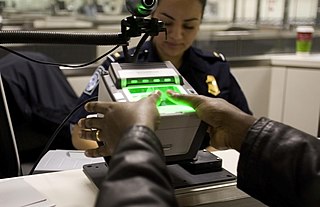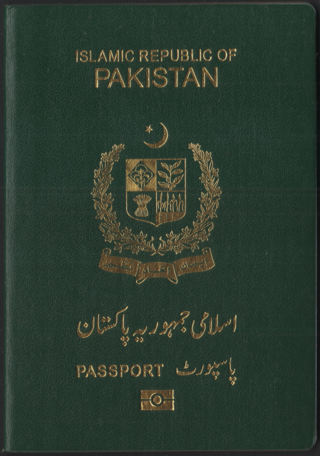Related Research Articles

A visa is a conditional authorization granted by a polity to a foreigner that allows them to enter, remain within, or leave its territory. Visas typically include limits on the duration of the foreigner's stay, areas within the country they may enter, the dates they may enter, the number of permitted visits, or if the individual can work in the country in question. Visas are associated with the request for permission to enter a territory and thus are, in most countries, distinct from actual formal permission for an alien to enter and remain in the country. In each instance, a visa is subject to entry permission by an immigration official at the time of actual entry and can be revoked at any time. Visa evidence most commonly takes the form of a sticker endorsed in the applicant's passport or other travel document but may also exist electronically. Some countries no longer issue physical visa evidence, instead recording details only in immigration databases.

United States Visitor and Immigrant Status Indicator Technology is a U.S. Customs and Border Protection (CBP) management system. The system involves the collection and analysis of biometric data, which are checked against a database to track individuals deemed by the United States to be terrorists, criminals, and illegal immigrants. US-VISIT is accessed by 30,000 users from federal, state, and local government agencies. Upon Presidential approval of the 2013 Continuing resolution the US-VISIT program officially became the Office of Biometric Identity Management (OBIM), save for portions of the agency which performed overstay analysis being transferred into U.S. Immigration and Customs Enforcement and biometric Entry and Exit operations which became a part of U.S. Customs and Border Protection.

A biometric passport is a traditional passport that has an embedded electronic microprocessor chip, which contains biometric information that can be used to authenticate the identity of the passport holder. It uses contactless smart card technology, including a microprocessor chip and antenna embedded in the front or back cover, or centre page, of the passport. The passport's critical information is printed on the data page of the passport, repeated on the machine readable lines and stored in the chip. Public key infrastructure (PKI) is used to authenticate the data stored electronically in the passport chip, supposedly making it expensive and difficult to forge when all security mechanisms are fully and correctly implemented.

The Singapore passport is a travel document and passport issued to citizens of the Republic of Singapore. It enables the bearer to exit and re-enter Singapore freely; travel to and from other countries in accordance with visa requirements; facilitates the process of securing assistance from Singapore consular officials abroad, if necessary; and requests protection for the bearer while abroad.
The European Union Visa Information System (VIS) is a database containing information, including biometrics, on visa applications by Third Country Nationals requiring a visa to enter the Schengen area.

The Albanian identity card (Letërnjoftim) is a national identity card issued by Albanian authorities to Albanian citizens. It is proof of identity, citizenship and residence. The current version is in ID1 format and biometric. The ID card is compulsory for citizens over 16 years of age, costs 1,500 lekë and is valid for 10 years.

Visa requirements for Pakistani citizens are the requirements by other countries to obtain a visa before entry on an ordinary Pakistani Passport.

Visa requirements for Indian citizens are administrative entry restrictions by the authorities of other states placed on citizens of India.

Visa requirements for French citizens are administrative entry restrictions by the authorities of other states placed on citizens of France.

Visa requirements for citizens of the Republic of Lebanon are administrative entry restrictions by the authorities of other sovereign countries and territories placed on citizens of the Republic of Lebanon.

Visa requirements for Dutch citizens are administrative entry restrictions by the authorities of other states placed on citizens of the Netherlands, the joint nationality of the four countries within the Kingdom of the Netherlands.

Visa requirements for Tuvaluan citizens are administrative entry restrictions by the authorities of other states placed on citizens of Tuvalu. As of 20 December 2020, Tuvaluan citizens had visa-free or visa on arrival access to 127 countries and territories, ranking the Tuvaluan passport 45th in terms of travel freedom according to the Henley Passport Index.
Visa requirements for Tongan citizens are administrative entry restrictions by the authorities of other states placed on citizens of Tonga. As of 2 July 2019, Tongan citizens had visa-free or visa on arrival access to 123 countries and territories, ranking the Tongan passport 46th in terms of travel freedom according to the Henley Passport Index.
Biometrics refers to the automated recognition of individuals based on their biological and behavioral characteristics, not to be confused with statistical biometrics; which is used to analyse data in the biological sciences. Biometrics for the purposes of identification may involve DNA matching, facial recognition, fingerprints, retina and iris scanning, voice analysis, handwriting, gait, and even body odor.
Visa requirements for Zimbabwean citizens are administrative entry restrictions by the authorities of other states placed on citizens of Zimbabwe. As of 2 July 2019, Zimbabwean citizens had visa-free or visa on arrival access to 64 countries and territories, ranking the Zimbabwean passport 80th in terms of travel freedom according to the Henley Passport Index.
Visa requirements for crew members are administrative entry restrictions imposed by countries on members of the crew during transit or turnaround.
On 3 February 2017, an Egyptian national in France on a tourist visa was shot as he rushed a group of French soldiers guarding a principal entrance to the Louvre Museum in Paris, France, with a machete. One soldier was injured in the fight. The soldiers were patrolling the museum as part of Opération Sentinelle, guarding the Carrousel du Louvre, in which an underground shopping mall also serves as a gift shop, ticket sales office, and public entrance to the museum.

The European Union Agency for the Operational Management of Large-Scale IT Systems in the Area of Freedom, Security and Justice (eu-LISA) is an agency of the European Union (EU) that was founded in 2011 to ensure the uninterrupted operation of large-scale IT systems within the area of freedom, security and justice (AFSJ), that are instrumental in the implementation of the asylum, border management and migration policies of the EU. It began its operational activities on 1 December 2012.

Automated border control systems (ABC) or eGates are automated self-service barriers which use data stored in a chip in biometric passports along with a photo or fingerprint taken at the time of entering the eGates to verify the passport holder's identity. Travellers undergo biometric verification using facial or iris recognition, fingerprints, or a combination of modalities. After the identification process is complete and the passport holder's identity is verified, a physical barrier such as a gate or turnstile opens to permit passage. If the passport holder's identification is not verified or if the system malfunctions, then the gate or turnstile does not open and an immigration officer will meet the person. E-gates came about in the early 2000s as an automated method of reading the then-newly ICAO mandated e-passports.

Visa requirements for German citizens are administrative entry restrictions by the authorities of other states placed on citizens of Germany.
References
- ↑ "Projet de loi de finances pour 2011 : Sécurité - Immigration, asile et intégration". Sénat (in French). The Senate of France. Retrieved 7 February 2017.
The VISABIO program, resulting from Act No. 2003-1119 of 26 November 2003 on the control of immigration, residence of foreigners in France and nationality, succeeds the BIODEV program. It consists of a computerized processing of biometric personal data (digitized photograph and fingerprint of the 10 fingers) of the visa applicants. It is represented by a security sticker identical to that used for non-biometric visas. The data is stored for five years in the central database
- ↑ "Projet de loi de finances pour 2011 : Sécurité - Immigration, asile et intégration". Sénat (in French). The Senate of France. Retrieved 7 February 2017.
The VISABIO national system has been adapted to connect to the European Visa Information System (VIS). The central system of the VIS is being qualified by the European Commission. Its delivery date, originally scheduled for December 2010, has been postponed until the fall of 2011. VIS is the world's largest biometric database, as it is expected to eventually contain identifiers of some 100 million, people.
- ↑ Jean Marc Manach (17 October 2007). "Milipol : la sécurité décomplexée". Le Monde (in French). Retrieved 7 February 2017.
Visabio is the French segment of the Visa Information System (VIS), the world's largest biometric database, which aims to centralize the photographs and fingerprints of all ten fingers of all visa applicants Of the European Union and ultimately the identifiers of some 100 million people.
- ↑ "Customs officer, a profession that evolves with society". The Maville of Brest (in French). Ouest France. 21 May 2013. Retrieved 7 February 2017.
The customs officers are equipped with Visabio, a system of control of biometric passports with document readers. Migration controls have priority over all others.
- ↑ "Automated biometric processing of foreigners is authorized". Europe1 (in French). 3 November 2007. Retrieved 7 February 2017.
Each year more than 2 million foreigners subject to the visa requirement will be involved in the automated processing of biometric data. [...] Only children under 6 years of age are exempt from the measure.
- ↑ Christophe Cornevin. "Attack of the Louvre: the assailant placed in custody". Le Figaro (in French). Retrieved 7 February 2017.
L'examen du téléphone iPhone 7 retrouvé dans la veste abandonnée sur les marches du Louvre, ainsi qu'une recherche sur la base européenne Visabio laissant apparaître photo et éléments biométriques des voyageurs, atteste qu'il s'agirait d'Abdullah Reda al-Hamamy, un Égyptien de 29 ans
- ↑ "Louvre attack suspect Egyptian national: Paris prosecutor". Yahoo News. Indo Asian News Service. Retrieved 7 February 2017.
Molins said the attacker was not carrying an ID but a photo registered in Visabio (a European biometric database including digital photography and fingerprints of visa applicants) was the same of the machete-wielding man.
- ↑ "Tentative d'attaque "terroriste" au musée du Louvre à Paris". Reuters (in French). Archived from the original on 3 February 2017. Retrieved 7 February 2017.
The Paris prosecutor, Francois Molins, said during a press conference in the evening that his life prognosis was "very probable". [...] The man did not carry papers and his identity was not formally established. But the search of a cell phone found in his backpack and research on the Visabio file, during the French translation of a European database, "targeted an individual of 29 years of Egyptian nationality" residing at United Arab Emirates, said the magistrate.
- ↑ Elspeth Guild, K Groenendjk, S Carrera (13 May 2016). Illiberal Liberal States: Immigration, Citizenship and Integration in the EU. Routledge. ISBN 978-0-7546-7698-0 . Retrieved 7 February 2017.
{{cite book}}: CS1 maint: multiple names: authors list (link)